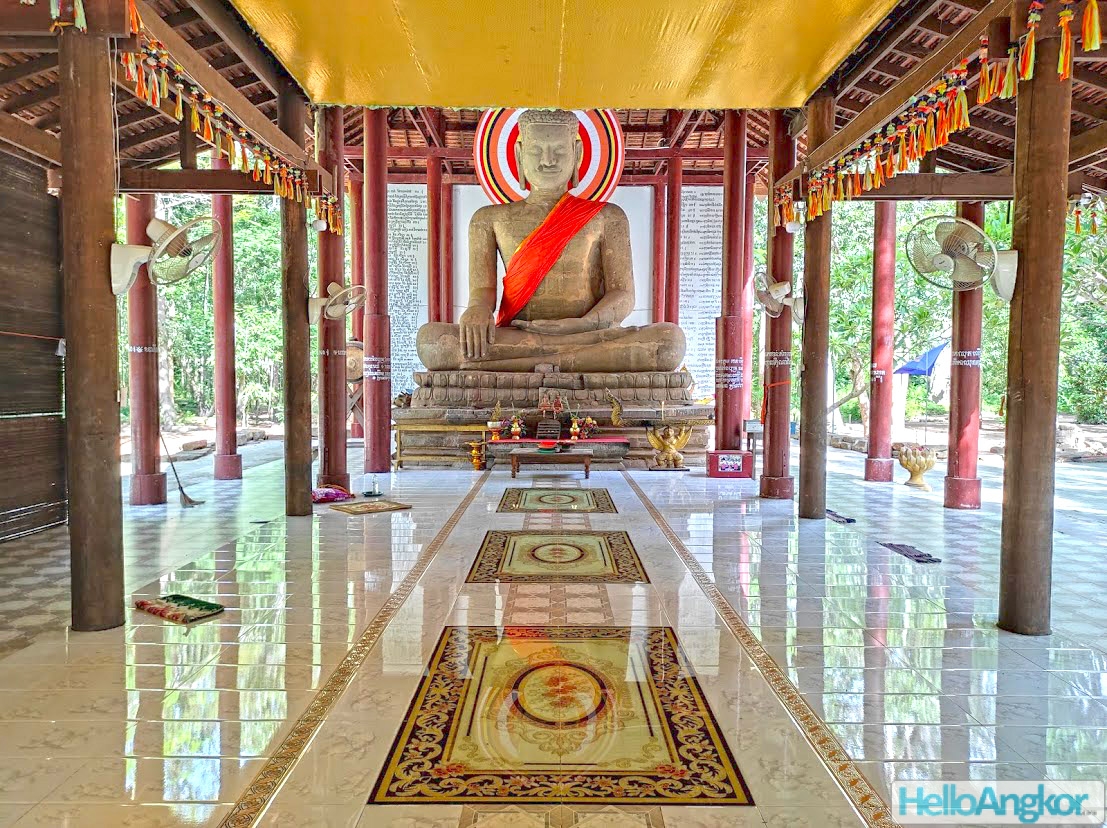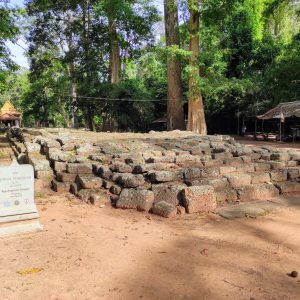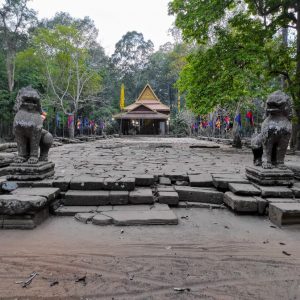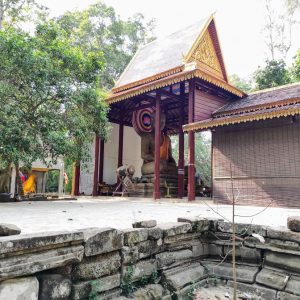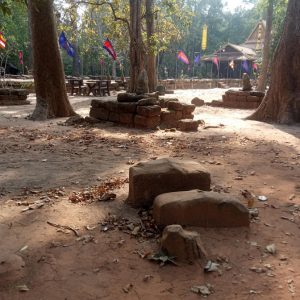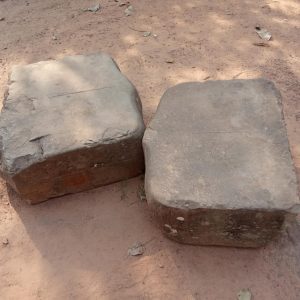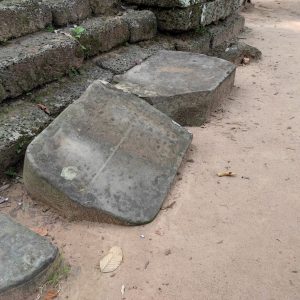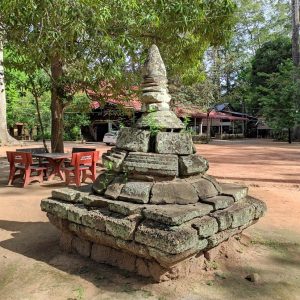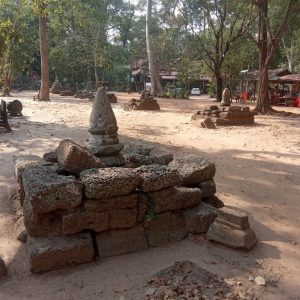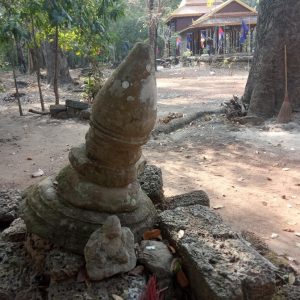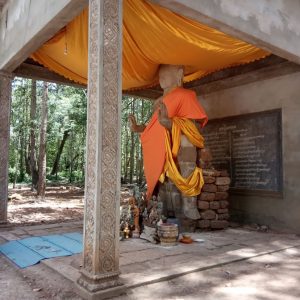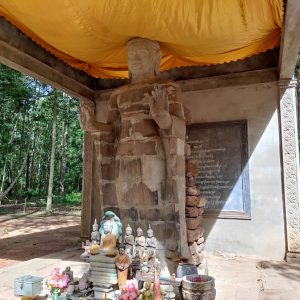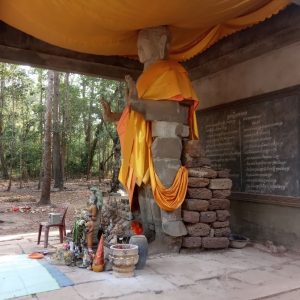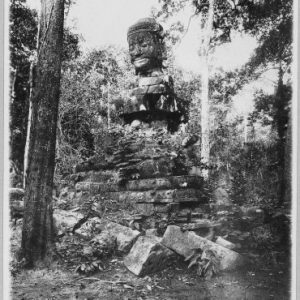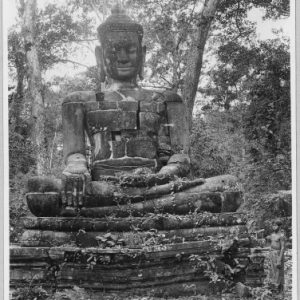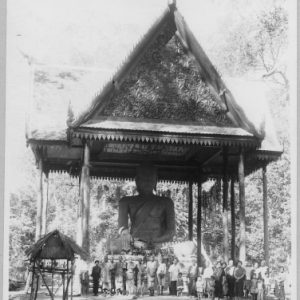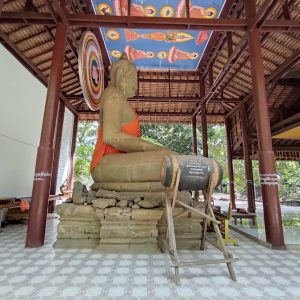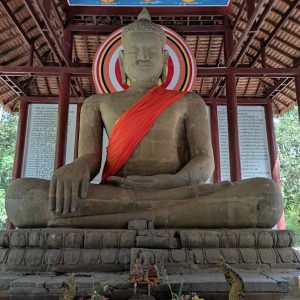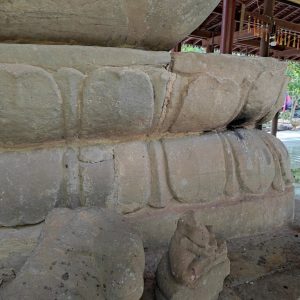- Area: Siem Reap Province > Krong Siem Reab > Sangkat Kouk Chak
- | Type: Ancient Remains & Temples
Tep Pranam (Khmer: ប្រាសាទទេពប្រណម្យ), located inside Angkor Thom, is a “Buddhist terrace” featuring seated lions and naga balustrades with a giant seated Buddha. It is located just north of the Terrace of the Leper King.
The terrace is typical of Buddhist Terrace constructions being low height, cruciform shape, and facing east. Preceded by an approx.. 60m long laterite causeway, the terrace opens with unique seated lions flanked by a naga balustrade. The terrace is 50 m long and 14 m wide with a 30 x 30 m cross-section that features a second low rise atop of which is the 6.0m high Buddha then covered by a modern replacement of its traditional wooden shelter/pagoda.
The terrace is surrounded by quite large sema stones, to my knowledge, the size of which only seen at two other sites in Angkor, perhaps further implying the importance of the site.
The terrace is surrounded by small chedei on the north, south and west, originally 25 in total.
Also on the western side, and not to be missed is the standing Buddha (4m in height) with arms placed outward to express fearlessness. It was noted in the early 1900s that this was originally placed by the edge of a nearby basin.
Tep Pranam’s Giant Buddha
In 1918, Henri Marchal noted the extensive damage the Buddha had suffered, perhaps due to looters chasing treasures while also noting signs of gilding. It’s unclear (to me at this time) how much of the Buddha was standing when first recorded by the French. An image circa 1920 shows the Buddha mostly upright (left pic below, middle pic undated, right pic circa 1950 Credit: EFEO, Persee).
The Buddha statue is 6 m high on a 1m high base. It is original to the site and was reconstructed by local and French teams in the 1950s. The Buddha is seated in the “touching the earth” position or Bhumisparsha mudra. The head of the Buddha features a ushnisha (hair bun) with a flame like tip which has been referenced to indicate that this statue is most certainly produced after 13th century.
History
Whilst at first glance, Tep Pranam would appear less interesting than its larger compatriots such as Bayon Temple, Baphuon Temple, etc., with only a giant Buddha as any sort of claim to fame for the casual visitor.
Actually, it is perhaps one of the more interesting sites in Angkor, in its first iteration possibly preceding the constructions that were built around it (Bayon, Angkor Thom itself etc) while also being a site that was part of reconstructions in the post-God-King era and the transition to Theravada Buddhism that is still in practice today.
How old is Tep Pranam exactly? An inscribed stele (K. 290) was found in the area, but its exact origin appears uncertain as to whether from here or more likely from sites that were located south of the East Baray. It speaks of an Acrama (Saugatasrama) founded in the 9th c by Yasovarman and the rules around such. It can be found on SEAlang’s corpus of Khmer Inscriptions.
During the reign of King Yasovarman I (reign: 889–910 BC) it is noted that the first institutions built were Acrama, or ashram/hermitages, with 100 across the empire supporting Vaishnavism, Shaivism, and Buddhism. There are four located in Angkor.
That leaves some uncertainty around the founding date of Tep Pranam, but regardless, it continues to be recorded as the 9th century.
Tep Pranam and later modifications
While Tep Pranam may date to the 9th century, the structures that we see today are later constructions using recycled stone masonry.
Structures in and around the Tep Pranam area have been modified extensively, including the Terrace of the Leper King and also wall that leads west from it, a basin, a cistern, and other linear features noted as being constructed/altered after the 14th century.
The transition to Theravadin Buddhism
The Khmer Empire went through numerous religious upheavals and transitions with the last transition to Theravadin Buddhism perhaps the most interesting as it has lasted and thrived till the present day. Yet, this transition is the least understood, and little is known about the constructions and cultural shift in the period between the 13-17th century, until now.
Around Angkor, there are approximately 70 structures, like Tep Pranam, that are related to Theravadin Buddhism and attributed to the 13-17th c which are being excavated and researched through the ongoing work of the Angkor Vihara Project and APSARA as mentioned in an earlier post on Buddhist Terraces here.
References
- Harris, Andrew. (2019). An Old Ritual Capital, a New Ritual Landscape: Understanding the Transformation of Angkor Thom, Cambodia through the Construction and Placement of Theravāda »Buddhist Terraces«. Medieval Worlds. medieval worlds. 4-62. 10.1553/medievalworlds_no9_2019s4
- Ref: Polkinghorne Martin, Vincent Brice, Thomas Nicolas, Bourgarit David. Casting for the King: The Royal Palace bronze workshop of Angkor Thom. In: Bulletin de l’Ecole française d’Extrême-Orient. Tome 100, 2014. pp. 327-358; doi : https://doi.org/10.3406/befeo.2014.6179 https://www.persee.fr/doc/befeo_0336-1519_2014_num_100_1_6179
- Marchal Henri. III. Notes sur les Terrasses des Eléphants, du Roi Lépreux et le Palais royal d’Ankor Thom. In: Bulletin de
l’Ecole française d’Extrême-Orient. Tome 37, 1937. pp. 347-360;
Map
Site Info
- Site Name: Tep Pranam (Pr.) Khmer Name: បា្រសាទទេពប្រណម្យ
- Reference ID: HA11661 | Last Update: July 17th, 2021
- Tags/Group: 9th Century, Angkor, Angkor Small Circuit, Angkor Thom, Buddhist Terrace, Map: Angkor's Top 30 Temples & Ancient Sites, Map: Top 100 Temples & Ancient Sites (Siem Reap), pr, Temples
- Location: Siem Reap Province > Krong Siem Reab > Sangkat Kouk Chak
- MoCFA ID: 377
- IK Number: 479
- Inscription Number/s: K. 290

